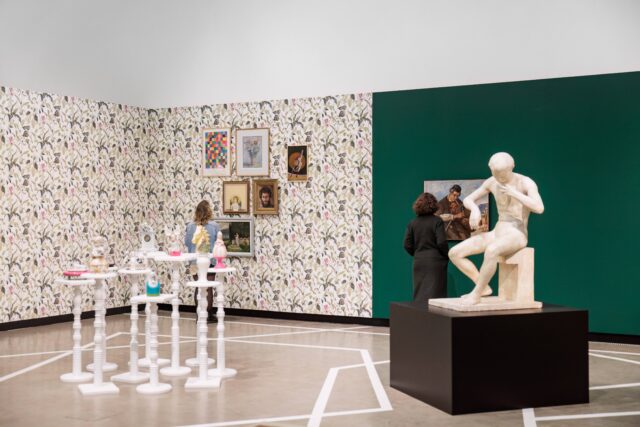
Gülsün Karamustafa
Gülsün Karamustafa (born 1946, lives and works in Istanbul and Berlin) is a visual artist and filmmaker known for interweaving personal and historical narratives with contemporary sociopolitical issues. One of the most relevant Turkish contemporary artists, her practice already spans more than five decades. Through painting, sculpture, and film, her work often reflects on the politically turbulent environment of her native Turkey, whether in Prison Paintings (1972–1978), a series of canvases created after her incarceration as a political prisoner, or in The Monument and the Child (2010), a collection of sculptures exploring the complex visual language of modern Turkey and its national monuments. Her works frequently combine elements of historical fact and personal experience, merging childlike impressions with harsh political realities.
Under the title The Crime Scene, Gülsün Karamustafa’s painting Window (1980) and the sculptural installation The Monument and the Child (2010), consisting of ten stands bearing playful ceramic objects, are juxtaposed with a small collection of works from MoCA Skopje. These two sculptures and nine paintings all entered the museum’s collection as a private donation from the family of Radmila Ugrinova-Skalovska. Consisting mostly of Macedonian artists, the collection to some extent reflects the points of view and ambitions of the family who diligently collected the works. It therefore begs the question of how to include such a body of work in the wider context of a museum collection and whether the works from the private collection should be separated out at all.
These questions are also highlighted by Gülsün Karamustafa’s works, which – especially Window – seem to ask at what specific points solidarity is possible and when it is not. The artist answers by placing the works into an imagined family room, complete with pleasant wallpaper and an armchair. The works from the collection of Radmila Ugrinova-Skalovska and Gülsün Karamustafa’s sculptures and painting begin to form a common narrative, but as each work starts to form a part of a whole, it also needs to be recognized individually. Using a method of the sort commonly seen in old crime movies, the artist traces the artworks with tape, reminiscent of white chalk, outlining their complex pasts while establishing their present relationships to one another. With this, the artist opens up the works and their complex relations with one another to investigation.


Interview with Gülsün Karamustafa
1. What were your impressions of Skopje and the Solidarity Collection of MoCA Skopje? What did you find interesting about the collection?
I believe what happened in Skopje after the earthquake in 1963 is unique and very touching. People were more concerned about each other’s problems in those days, and that makes me think that this kind of solidarity will never happen again. Destructive wars are continuing around us. Though we claim that people are in close contact, and we know more than ever about what is happening in the world through technological possibilities, we have never been more ignorant about each other’s grievances.
2. How do you relate the works you chose from the collection to your own practice?
My choices from the MoCA Skopje collection are more about the sculptures and paintings by Macedonian artists as they relate to daily life. Therefore, I wanted to complement them with one painting with a political context and one cheerful sculptural work from my own practice. My wish is to create a peculiar but interesting conversation between those works that may never come together again in the future.
3. What is your view on solidarity in the art world today? Do you think something similar to the MoCA Skopje donations can happen?
Unfortunately, relationships in the art world are more based on profit and self-interest nowadays. Of course, there are attempts by artists and some institutions to break this understanding, by giving more opportunities for collective activities and mutual productions and by creating cross-overs between artists and institutions. But the power of capital always finds ways to break through the solidarity.



